Jacques-Louis David (1748-1825) is considered to be the leading Neoclassical painter of his time. He permanently moved away from the frivolous ideals of the Rococo artists as the end of the Ancien Régime was approaching.
This is remarkable because his initial mentor was François Boucher (1703-1770), the court painter of Louis XV and a leading Rococo artist of his time.
His gradual transition happened just before the French Revolution and his political motivation played a role in it. The French artist initially joined the revolutionaries and eventually fully supported Napoleon Bonaparte, becoming his painter.
Let’s take a closer look at some of the most famous Jacques-Louis David paintings, Neoclassical artworks that defined the Neoclassical era of the late 18th and early 19th centuries.
1. Oath of the Horatii
- Date created: 1784
- Dimensions: 329.8 × 424.8 centimeters (129.8 × 167.2 inches)
- Location: Louvre Museum, Paris, France
Oath of the Horatii isn’t just one of the most famous paintings by Jacques-Louis David but also one of the best-known Neoclassical paintings ever created. It depicts a legend dating back to the 7th century B.C. in which 3 sons salute their father just before going to a fight.
The fight between Rome and Alba Longa was decided by a battle of 3 soldiers of each party. Here we can see 3 Roman brothers of the Horatii family who prepare to fight 3 brothers of the Curiatii family who belonged to Alba Longa. According to the legend, only one of the 3 brothers survived this battle.
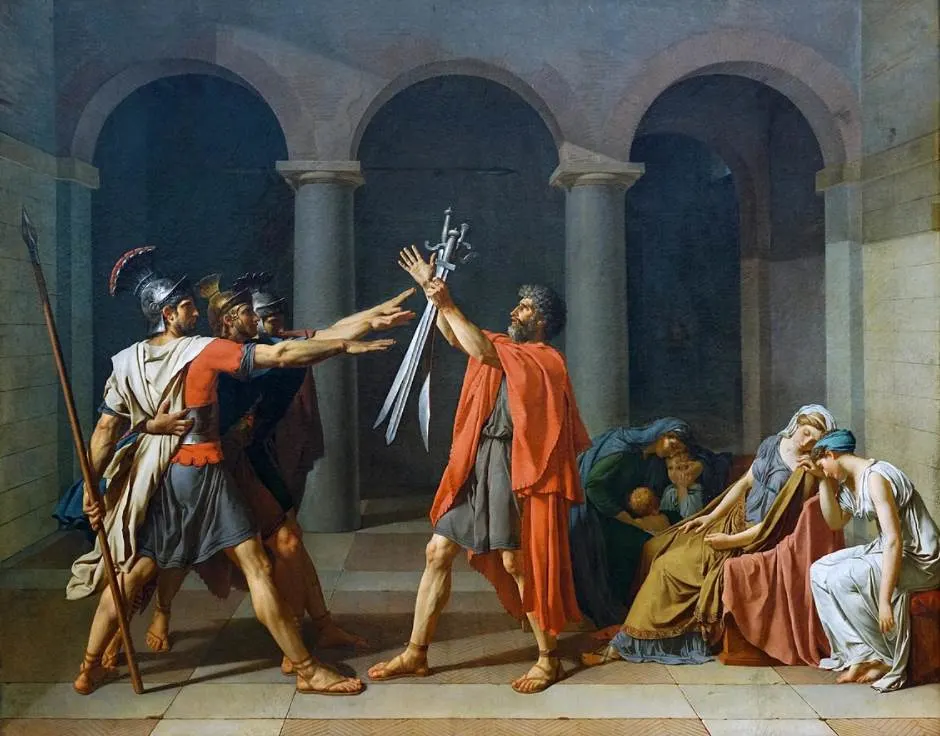
2. Napoleon Crossing the Alps
- Date created: 1801
- Dimensions: 261 × 221 centimeters (102.3 × 87 inches)
- Location: Château de Malmaison, Rueil-Malmaison, France
Napoleon Crossing the Alps is also known as “Napoleon at the Saint-Bernard Pass” and is one of 5 similar paintings in a series of equestrian portraits of Napoleon Bonaparte. All these paintings were painted between 1801 and 1805, around the time that the Napoleonic Wars were in full swing.
The depicted moment is an idealized version of Napoleon Bonaparte and his army crossing the Saint Bernard Pass, the highest road in the Swiss Alps, in May 1800. It’s one of the most famous portraits of Napoleon and has been reproduced countless times.
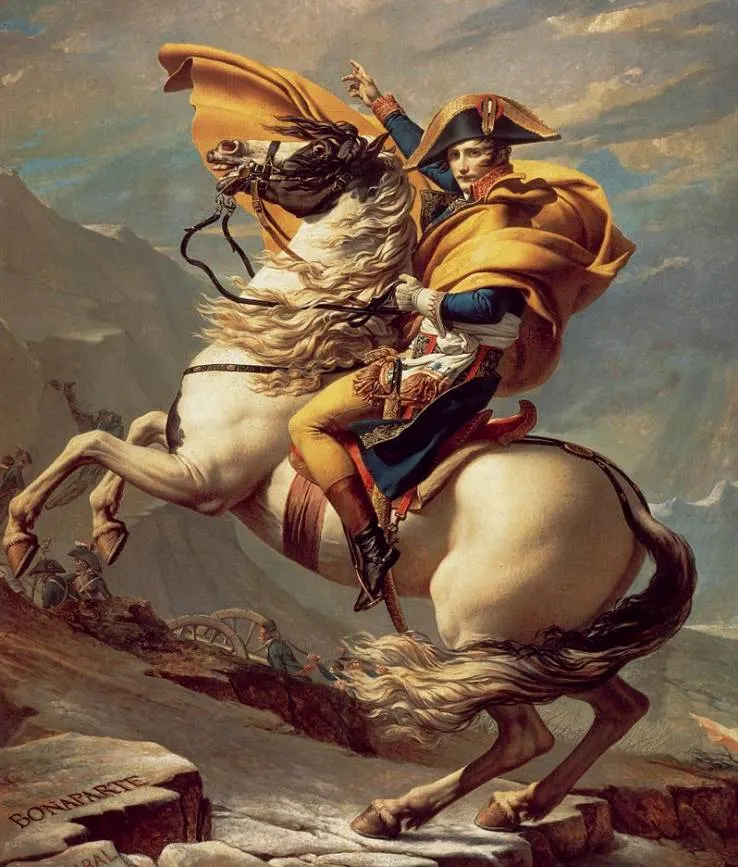
3. The Death of Socrates
- Date created: 1787
- Dimensions: 129.5 × 196.2 centimeters (51 × 77.2 inches)
- Location: Metropolitan Museum of Art, New York City, United States
The Death of Socrates is one of the many Jacques-Louis David paintings with a popular classical subject that he produced during the 1780s. It depicts the moment just before Socrates is about to be executed by having to drink poison, a story told in Plato’s “Phaedo.”

The reason why he was sentenced to death by drinking poisoned hemlock is that he allegedly brainwashed the youth of Athens with his philosophical stories that didn’t rhyme with the people in power in ancient Greece at the time. He can be seen telling his final story as he calmly accepts his faith.
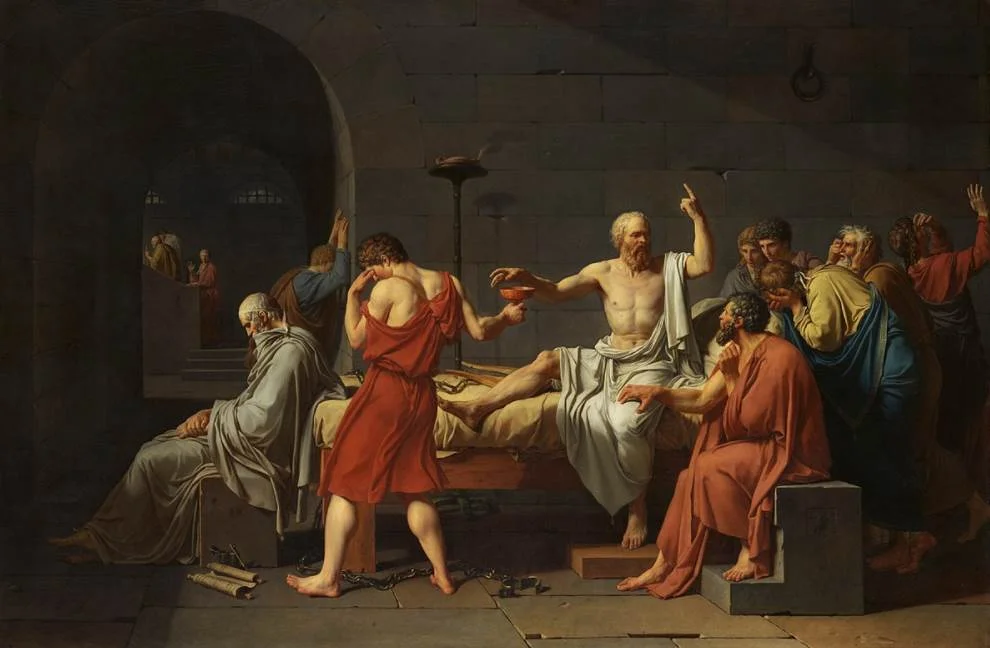
4. The Coronation of Napoleon
- Date created: 1805-1808
- Dimensions: 6.21 × 9.79 meters (20 feet 4 inches × 32 feet 1 inch)
- Location: Louvre Museum, Paris, France
The Coronation of Napoleon was painted at a time when Jacques-Louis David was already the personal painter of Napoleon Bonaparte, a ma,n he fervently admired. It depicts the moment that Napoleon is crowned as French Emperor at Notre-Dame de Paris in December of 1804.
Although David only started working on the painting a year after the event, he was able to attend this remarkable event in history so he had a pretty good recollection of what happened. He still added finishing touches to this monumental painting in January 1808.
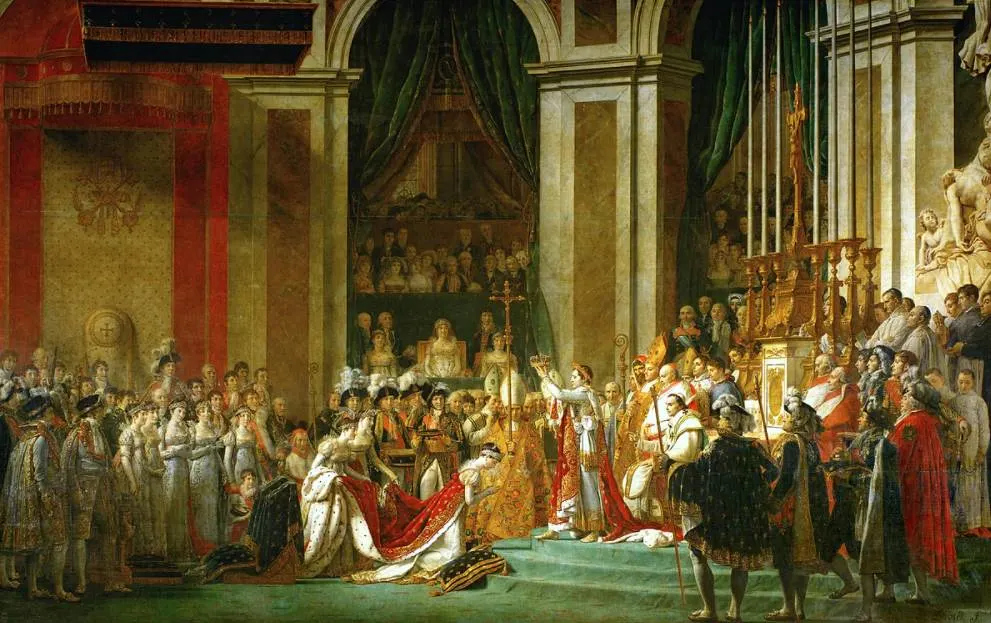
5. The Death of Marat
- Date created: 1793
- Dimensions: 162 × 128 centimeters (64 × 50 inches)
- Location: Royal Museums of Fine Arts of Belgium, Brussels, Belgium
The Death of Marat depicts another political event that happened over a decade earlier at the height of the French Revolution. David was a fervent follower of the revolution and produced an idealized version of the assassination of Jean-Paul Marat, one of the revolutionary leaders.
The leader of the Jacobin group was murdered while he was taking a medicinal bath by a supporter of the Girondins, a young woman named Charlotte Corday. It’s clear that David and Marat were part of the same political group and he intended to immortalize the man he admired.

6. The Lictors Bring to Brutus the Bodies of His Sons
- Date created: 1789
- Dimensions: 323 × 422 centimeters (127 × 166 inches)
- Location: Louvre Museum, Paris, France
The Lictors Bring to Brutus the Bodies of His Sons is another painting depicting a classical story that allegedly took place in Ancient Rome. It depicts Lucius Junius Brutus, the man who found the Roman Republic and maintained it at a great cost.
The First Consul of the Roman Republic ordered the execution of his sons because they were involved in a plot to overthrow him and restore the monarchy. This means that he sacrificed his family to retain the Roman Republic in the 6th century B.C.
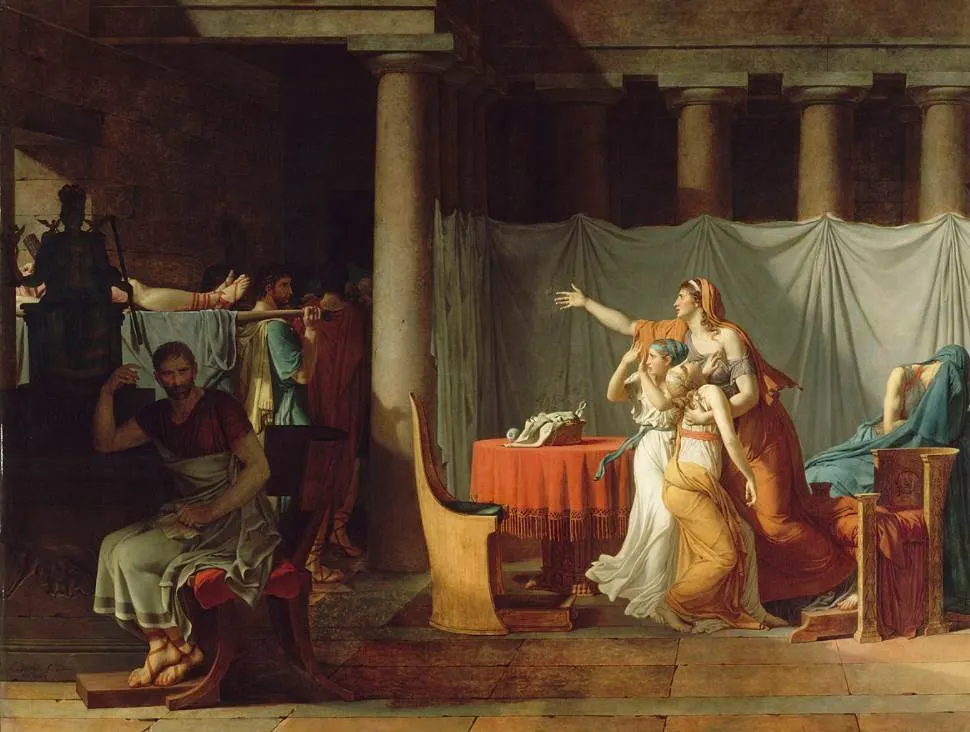
7. The Intervention of the Sabine Women
- Date created: 1799
- Dimensions: 385 × 522 centimeters (152 × 206 inches)
- Location: Louvre Museum, Paris, France
The Intervention of the Sabine Women depicts an episode that allegedly took place around the foundation of Rome in which Romans supposedly kidnapped young women from nearby towns and cities. This allegedly took place in the mid-8th century B.C.
This case of mass abduction is also sometimes referred to as the “Rape of the Sabine Women” and has been a popular subject in art. It doesn’t refer to an act of sexual violence but is a translation from the Latin word “Raptus” which means “kidnapping” or “abduction.”
8. Portrait of Madame Récamier
- Date created: 1800
- Dimensions: 174 × 224 centimeters (68.50 × 88.58 inches)
- Location: Louvre Museum, Paris, France
Portrait of Madame Récamier depicts a Parisian socialite named Juliette Récamier (1777-1849). It’s the ultimate Neoclassical version of a portrait as she is depicted in the typical reclining pose wearing classical clothes.
Although the painting was started in May 1800, the artist didn’t complete it when he heard that one of his colleagues named François Gérard had earned a similar one. Whether or not he intended to leave the empty background as it appears in the painting remains unclear.

9. Emperor Napoleon in His Study at the Tuileries
- Date created: 1812
- Dimensions: 203.9 × 125.1 centimeters (80.3 × 49.3 inches)
- Location: National Gallery of Art, Washington, D.C., United States
Emperor Napoleon in His Study at the Tuileries depicts Napoleon Bonaparte as he is dressed in uniform in his private office at the Tuileries Palace in Paris. Likely, Napoleon never posed for this portrait, despite the amazing level of detail he included in this remarkable work of art.
Although David put in a tremendous amount of effort in creating an almost photographic portrait, it was commissioned by Napoleon Bonaparte himself. The man who ordered it was Alexander Hamilton, 10th Duke of Hamilton, an equally fervent admirer of the French Emperor.
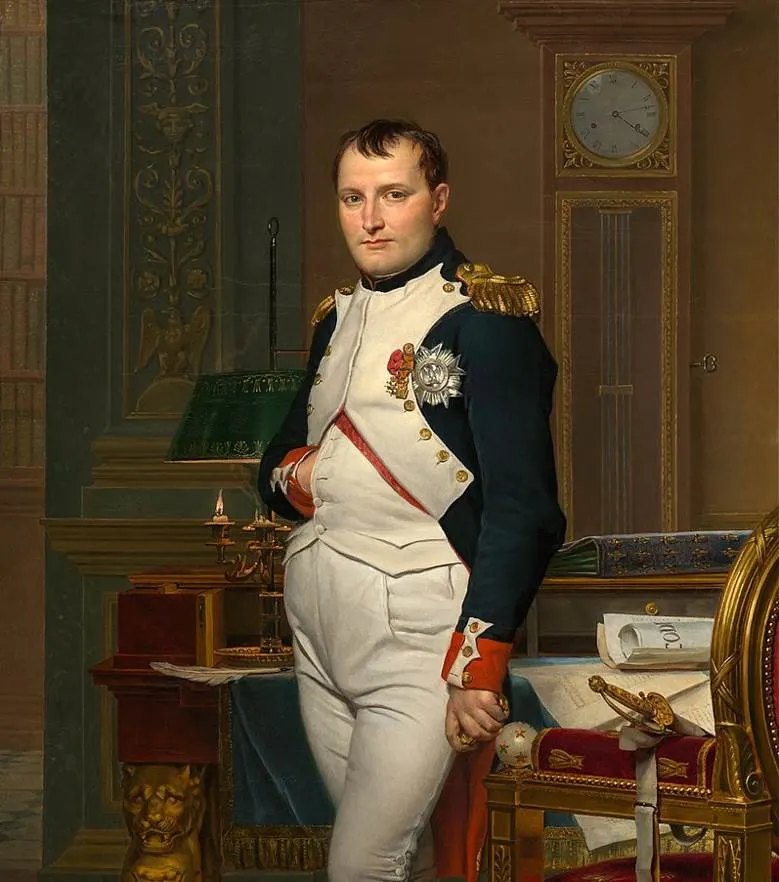
10. Mars Being Disarmed by Venus
- Date created: 1822-1824
- Dimensions: 308 × 265 centimeters (121 × 104 inches)
- Location: Royal Museums of Fine Arts of Belgium, Brussels, Belgium
Mars Being Disarmed by Venus is the final work of art that Jacques-Louis David produced during his lifetime. He started working on it at the age of 73 in the year 1822 and completed it the year that he passed away during his exile to Brussels in 1824.
The painting depicts the Roman god Mars and the goddess Venus along with Cupid and the Three Graces. They are depicted in front of a floating temple that appears in the clouds. We can see the moment that Mars removes his armor and gives in to the charm of Venus.

